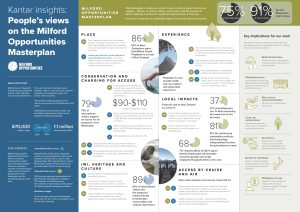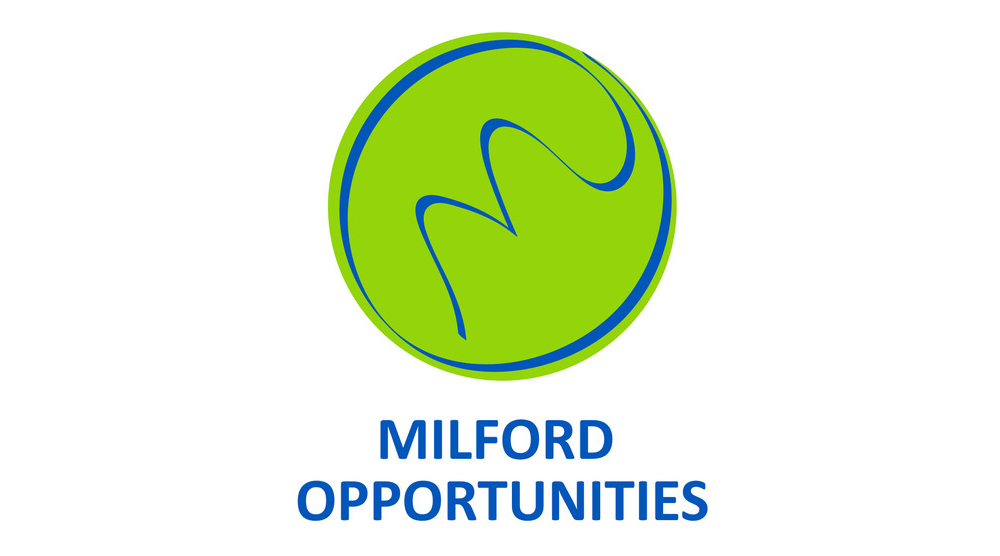Media release: Research reveals consumer insights on Milford Sound
14 September 2023
New domestic and international research shows people highly value Milford Sound Piopiotahi and expect sustainable, respectful tourism approaches, that preserve its natural and cultural essence.
The Milford Opportunities Project is today releasing research commissioned to inform the project’s work into how best to manage tourism to Piopiotahi for the benefit of people and place.
Through two separate reports, it looks at domestic and international travellers’ perceptions of Piopiotahi Milford Sound and the Milford Opportunities Masterplan.
“The Milford Opportunities Project delivered an innovative masterplan in 2021, identifying recommendations for safeguarding this place into the future,” says Milford Opportunities Programme Director Chris Goddard.
“Our work now is to test the feasibility of the masterplan’s recommendations. Alongside a significant engagement programme, this research is essentially our foundation for understanding at a high level what New Zealanders and overseas visitors value most about this area. How do they want to see Piopiotahi managed into the future, how do they want to enjoy it, and is the masterplan on track to deliver that?”
The consumer research findings include that the Milford Opportunities Masterplan is widely perceived to have a positive impact on the four capitals – Nature, Economy, Culture, and Society, with a belief it will lead to significant improvements in the area.
The majority of domestic (75%) and international (91%) respondents liked the masterplan and its ideas. Results show that:
- 86% of New Zealanders agree that Milford Sound Piopiotahi is an icon of New Zealand;
- 72% of surveyed Kiwis and 87% international markets like the concept of managed access/transportation with Te Anau as a visitor hub;
- 79% of international visitors support paying an access fee; and
- 89% of international visitors like the proposed enhancements to landscape, conservation and cultural experiences.
“What we are seeing is not just that people are OK with the masterplan’s vision for Piopiotahi, it is telling us that in many cases New Zealand needs to keep up with people’s expectations for how our treasured natural areas should be managed,” said Chris Goddard.
“Yes, there should be a charge for international visitors that ensures visitors cover the conservation and infrastructure costs of their visit. Yes, reduce the number of cars on the road and promote low-carbon buses from Te Anau. Yes, we should honour the history and significance of this place to Ngāi Tahu. Yes, we should ensure tourism practices are sustainable and in keeping with this UNESCO World Heritage Area.”
However, some results are more complex, highlight public concerns, or need more work says Chris Goddard.
“On the one hand, 68% of New Zealanders see the masterplan stimulating economic growth and creating employment opportunities in the area, on the other 37% of Southlanders are worried it could lead to Te Anau becoming too expensive to live for locals. There are also worries about the cost of the project to New Zealand.”
There was some support for the proposals to phase out big cruise ships and the aerodrome (61% of New Zealanders and 86% internationals). However, New Zealanders had questions around removing the aerodrome, raising concerns around this leading to more noisy helicopters or questions around safety.
“Further work is needed to look at cruise and the aerodrome separately – alongside significant work to understand if these recommendations are viable and desirable for Piopiotahi and the area’s communities,” said Chris Goddard.
The research flagged as a concern (28% New Zealanders and 32% international) that the plan does not go far enough in reducing the number of visitors, and therefore, it may not have a meaningful impact on restoring the environment.
“This research has shown us that people like the plan for enhancing and protecting Piopiotahi, but in delivering it, we must preserve the essence of this place and ensure its untouched natural beauty remains at the forefront of any experience.
“The project team must be continuously mindful of any wider implications from this work. Separate University of Otago research commissioned by Milford Sound Tourism Limited shows high satisfaction levels for 94% of visitors to Piopiotahi. We must ensure we uphold all that is already great about this place – community, nature, Kiwis getting outdoors, memorable tourism experiences.
“An extensive engagement programme is underway to make sure this work is informed by the experience and wisdom of the community, conservation and recreation groups, experts, tourism operators and users of the National Park and the Milford Highway.
“We now need to keep moving at pace to test and design options that are viable and will truly deliver for Piopiotahi and New Zealand.”
ENDS


